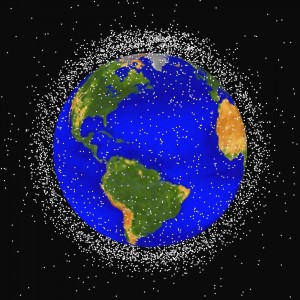The amount of space junk floating around the Earth grows every year, and increasingly can pose risks to spacecraft orbiting the planet.

This computer generated graphic provided by NASA shows objects in Earth orbit that are currently being tracked. Space junk has made such a mess of Earth’s orbit that experts say we may need to finally think about cleaning it up. (AP)
In the United States, NASA’s Orbital Debris Program (ODP) at the Johnson Space Center in Texas, keeps an eye on the ever-expanding junkyard of space.
“We define orbital debris as any man-made object orbiting the Earth that is no longer serving a useful purpose,” says Gene Stansbery, project manager for the ODP. “That can be anything from very large rocket bodies and dead satellites that are no longer useful, all the way to very tiny particles that are eroded from the painted surfaces of spacecraft or rockets, the entire size range.”
In the weightless and friction-free environment of orbit, it’s not so much the size of all this junk floating in the Earth’s orbit, but also the speeds at which it travels, according to Stansbery.
“If you look at orbital velocities and the average collision velocity, you’re talking on the order of 11 kilometers a second,” he says. “So even a small paint fleck can damage a sensitive component for spacecraft.”
An example occurred during STS 7, when a window for the space shuttle had to be replaced for the first ever time after being damaged by a .2 millimeter paint fleck. If that level of damage can be caused by a particle that small, one can imagine the threat posed by larger orbiting refuse.
Given that space exploration has been an on-going venture since the 1950s, there’s a lot of old stuff circling the planet, and much of it can pose serious risks.
“The Department of Defense has a world-wide network that can track objects down to about 10 centimeters in size in low Earth orbit,” says Stansbery. “For those objects, there’s about 22,000 that they’re tracking. You go down to about one centimeter and larger, you’re talking about 500,000, and if you get smaller than that and you’re talking into the millions.”
Some of that stuff, especially in low-Earth orbit, will eventually fall back to the planet, much of it burning up on re-entry. However, for junk found at higher altitudes, around 1,000 kilometers or so, Stansbery says it could remain in orbit for decades, maybe even hundreds of years. For altitudes even higher than that, junk could remain for centuries…or longer.

A white arrow points to damage on a piece of a solar array from the Russian space station Mir. The array had been damaged by a miniscule piece of space junk. (AP)
Major collisions are rare, but they do happen. On Feb. 10, 2009, two large satellites, the Iridium 33 and the Kosmos 2251, collided at a speed of about 42,000 kilometers per hour. The collision spread about 1,000 pieces of debris capable of being tracked across the skies, where much of it remains.
In March of this year, one of those pieces came uncomfortably close to the International Space Station. So close, in fact, that as a precaution, the ISS’ six-member crew waited for a time in the Soyuz emergency exit capsule, just in case a collision occurred and they had to abandon ship.
More worrisome, says Stansbery, is that the crew only had 24 hours notice of the possible collision. “Unfortunately, that is too short a time to plan a re-avoidance maneuver for the space station,” he says.
The threat posed by space junk isn’t new; space scientists have been concerned about it since the 1970s. However, with more rockets taking off, more satellites in the sky, and more spacecraft – such as from China or private firms like SpaceX and Blue Origin – the skies are getting more crowded all the time.
This week on VOA’s “Science World” radio program, you can hear the complete interview with Gene Stansbury on space junk, as well as other features on the science behind children’s snack food choices, the lingering effects of the Gulf of Mexico oil spill on corral communities, and a new web-based computer program that helps doctors save lives. Take a look at the right hand column for scheduled times.
(Written by Doug Bernard, Digital Frontiers Editor)





















The problem can’t be solved unless we find a new way to launch satellites.
Each and every launch creates more debris.
Telecomsat G2 is self-launching, recyclable, and leaves behind zero debris.
Learn more at my website.
Steve Smyth
Space Debris or Junk does not just pose a risk to space craft in orbit, but I believe it also poses a threat to everything here on Earth. Far more Space Debris is managing to survive its frictional path through our atmosphere and impact our planet than Scientists are prepared to admit to. The evidence is clearly out there to be investigated, take a look at all the incidents such as fires for one example that occur on a regular basis around the world. The sooner we clear this mess up, the better for everybody. JOHN HALL (RAISD)
We really need orbiting passive collector nets for the smaller particles.
They could target various streams from past collisions to finally be bundled up and jettisoned to burn up at lower altitude. Then a new net could be employed. What we need is a space going spider :o)